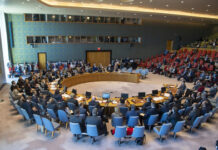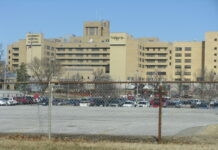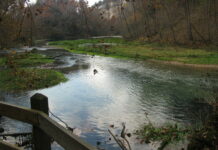Photo credit: DiasporaEngager (www.DiasporaEngager.com).
On August 26, 2020, this report was posted online as an MMWR Early Release.
The World Health Organization declared coronavirus disease 2019 (COVID-19) a pandemic on March 11, 2020.* Shortly thereafter, closures of 124,000 U.S. public and private schools affected at least 55.1 million students through the end of the 2019–20 school year.† During the summer of 2020, approximately 82% of 8,947 U.S. overnight camps did not operate.§ In Maine, only approximately 20% of 100 overnight camps opened.¶ An overnight camp in Georgia recently reported SARS-CoV-2, the virus that causes COVID-19, transmission among campers and staff members when nonpharmaceutical interventions (NPIs) were not strictly followed (1); however, NPIs have been successfully used to mitigate SARS-CoV-2 transmission among military basic trainees (2). During June–August 2020, four overnight camps in Maine implemented several NPIs to prevent and mitigate the transmission of SARS-CoV-2, including prearrival quarantine, pre- and postarrival testing and symptom screening, cohorting, use of face coverings, physical distancing, enhanced hygiene measures, cleaning and disinfecting, and maximal outdoor programming. During the camp sessions, testing and symptom screening enabled early and rapid identification and isolation of attendees with COVID-19. Among the 1,022 attendees (staff members and campers) from 41 states, one territory, and six international locations, 1,010 were tested before arrival; 12 attendees who had completed a period of isolation after receiving a diagnosis of COVID-19 2 months before arrival were not tested. Four (0.4%) asymptomatic attendees received positive SARS-CoV-2 test results before arrival; these persons delayed their arrival, completed 10 days of isolation at home, remained asymptomatic, and did not receive any further testing before arrival or for the duration of camp attendance. Approximately 1 week after camp arrival, all 1,006 attendees without a previous diagnosis of COVID-19 were tested, and three asymptomatic cases were identified. Following isolation of these persons and quarantine of their contacts, no secondary transmission of SARS-CoV-2 occurred. These findings can inform similar multilayered public health strategies to prevent and mitigate the introduction and transmission of SARS-CoV-2 among children, adolescents, and adults in congregate settings, such as overnight camps, residential schools, and colleges.
Summer camps are a $26 billion dollar industry; approximately 15,000 day and overnight camps in the United States employ approximately 1.5 million staff members and host an estimated 26 million children annually. The Maine Department of Health and Human Services (DHHS) licenses Maine summer camps, which serve 20,000–25,000 children from the United States and other countries each year. Previous studies suggest that isolation and physical distancing measures likely mitigated disease during the influenza pandemic of 1918 and prevented spread of the coronavirus SARS-CoV, which caused the severe acute respiratory syndrome (SARS) epidemic in 2003 (3,4). During the 2009 influenza A virus (pH1N1) pandemic, CDC issued guidance for influenza prevention and control in camp settings focusing on early identification and isolation of ill persons and enhanced hygiene.** Camps operating in Maine during the pH1N1 2009 season followed public health guidance and implemented recommended preventive measures. Although many camps reported influenza-like illness and outbreaks, major disruptions were not reported (5).
To prevent, identify, and mitigate spread of COVID-19, four Maine overnight summer camps with similar size, session duration, and camper and staff member characteristics opened with uniform NPIs, including precamp quarantine, pre- and postarrival testing and symptom screening, cohorting, and physical distancing between cohorts. In addition, camps required use of face coverings, enhanced hygiene measures, enhanced cleaning and disinfecting, maximal outdoor programming, and early and rapid identification of infection and isolation.
All attendees were instructed to quarantine with their family unit (unless parents were essential workers††) for 10–14 days before camp arrival. No camp restricted attendance from any part of the country or globally but did advise on mode of travel (preferred mode was direct to camp in family vehicle; riders on camp buses wore face coverings, with physical distancing monitored by staff members; and air travelers were instructed to wear face coverings while traveling). Study activities were conducted by the medical directors and health staff members at each camp and under exempt approval by the Institutional Review Board of the University of Virginia.
Attendees with COVID-19 were defined as detection of SARS-CoV-2 by reverse transcription–polymerase chain reaction (RT-PCR) testing. Approximately 5–7 days (mean = 2.4–9.4 days) before camp arrival, 1,010 of the 1,022 attendees were tested for SARS-CoV-2 by RT-PCR at the attendees’ primary care providers or at commercial laboratories that provided services directly to consumers, including camps and schools according to Food and Drug Administration’s Emergency Use Authorizations. Attendees with self-reported symptoms consistent with COVID-19 as defined by CDC (https://www.cdc.gov/coronavirus/2019-ncov/symptoms-testing/symptoms.html) before camp arrival were referred to their primary care provider for further evaluation. Three of four camps mandated submission of test results before camp entry, and delays in receipt of test results caused one camp to isolate 15 campers until negative results were known, up to 4 days after camp arrival.
To address potential late exposures or exposures during travel, all camps quarantined attendees by cohort for 14 days after camp arrival, regardless of testing or screening results. Each camp implemented NPIs with careful attention to the population served, physical attributes of the camp, and camp-specific daily programming to identify and mitigate high-transmission–risk activities occurring between cohorts. All attendees received instruction on hygiene measures such as cough and sneeze etiquette and hand hygiene, with the requirement to clean hands with soap and water or hand sanitizer containing a minimum of 60% ethanol or 70% isopropanol before and after all activity periods, meals, and other high-touch interactions. Compliance with all NPIs was monitored by staff members. Staff members did not leave camp during the session for days off.
After camp arrival, campers and staff members were screened by health staff members at least daily (at one camp twice daily) for fever (temperature >100.4°F [38°C]) with infrared thermometers and through direct questioning for symptoms consistent with COVID-19. Programmatic changes to usual camp activities included limiting indoor activities that mixed cohorts, staggering dining periods or dining outdoors, cohort-specific programming, and limiting sports to those that allowed for physical distancing between staff members and cohorts. Stable cohorts were based on living quarters (e.g., bunk assignment) or age division and ranged in number from 5–44 attendees. If interacting outside the cohort, attendees were required to wear face coverings and maintain a physical distance of 6 feet for a minimum of 14 days. Bathroom use was organized by cohort using separate bathrooms or staggering use. In general, cleaning and disinfection of the camps followed the Maine Center for Disease Control and American Camp Association Field Guide for Camps on Implementation of CDC Guidance.§§ Shared items were cleaned and disinfected as much as possible, with high touch areas (e.g., door handles or railings) being cleaned more frequently. Personal sports equipment and shared items were disinfected immediately after use, or a minimum of 24 hours was required before subsequent use. Kitchens followed standard protocols, as well as state COVID-19 protocols for restaurants. Bathrooms were cleaned and disinfected twice daily. Camps attempted to use single-use items, such as milk cartons and single-use condiment packs or silverware, to the extent possible.
RT-PCR testing was repeated a mean of 4.1 to 9.1 days after camp arrival for 1,006 attendees, with results available approximately 2–3 days later; no attendees declined testing. Attendees with positive SARS-CoV-2 test results or those who reported symptoms consistent with COVID-19 were isolated immediately, and their cohort was quarantined until the attendee received a negative test result.
Before the 1,022 attendees departed for camp, four (0.4%) asymptomatic attendees received positive SARS-CoV-2 test results and delayed their arrival; they were subsequently isolated for 10 days at their homes, were not retested before camp entry, were considered to not have COVID-19 at time of camp arrival, and did not receive any further testing for the duration of their attendance. Twelve attendees (nine staff members and three campers) were not tested before travel to camp because they had completed a period of isolation after experiencing symptoms and having received positive SARS-CoV-2 RT-PCR test results in the 2 months before camp opening. The remaining 1,006 attendees received negative SARS-CoV-2 test results.
During June–August, the combined attendance of the four camps included 642 children and 380 staff members, aged 7–70 years, from 41 states with a variety of 7-day average rate of SARS-CoV-2 infection (Figure); 1.8% of camp attendees¶¶ (10 staff members and eight campers) came from six international locations (Bermuda, Canada, Mexico, South Africa, Spain, and United Kingdom) and Puerto Rico (Table 1). Camp sessions ranged from 44 to 62 days (including a 14-day staff member orientation) during June 15–August 16, 2020. The number of campers in cabins (including dormitory-style quarters) ranged from five to 44 campers (Table 2). No attendee reported a condition that precluded wearing a face covering, and all attendees were observed to comply with use of face coverings and physical distancing.
Daily symptom checks identified 12 attendees (one staff member and 11 campers) (1.2%) with signs or symptoms compatible with COVID-19; symptomatic persons were immediately isolated and tested, and their cohorts were quarantined until test results were available. All 12 isolated attendees received negative test results, after which isolation and cohort quarantine were discontinued.
Three asymptomatic attendees at three different camps (two staff members and one camper) (0.3%) received positive SARS-CoV-2 test results after arrival at camp and were rapidly isolated and their cohorts (sized five, six, and 30 attendees) quarantined for 14 days per state and CDC guidance. Both asymptomatic staff members isolated for 10 days and received negative test results twice 24 hours apart at the end of their isolation. The asymptomatic camper was isolated on day 3 after testing when positive test results were received. The camper was retested on days 4 and 5 after a positive test result and released from isolation on day 8 after a second negative result was received (per CDC isolation termination guidelines at that time). The 30 members of the camper’s cohort were retested on days 3 and 4 after the asymptomatic camper’s initial positive test result. No cohort members received a positive test result, and all were released from quarantine on day 8 after the asymptomatic camper’s positive test result. No secondary transmission was identified.
| Characteristic | No. (%)* |
|---|---|
| Total | 1,022 (100) |
| Sex | |
| Male | 470 (46) |
| Female | 552 (54) |
| Role | |
| Camper | 642 (63) |
| Staff member | 380 (37) |
| Age group, yrs† | |
| 7–8 | 30 (3) |
| 9–10 | 135 (13) |
| 11–12 | 175 (17) |
| 13–14 | 184 (18) |
| 15–18 | 133 (13) |
| 19–21 | 151 (15) |
| 22–29 | 126 (12) |
| 30–49 | 45 (4) |
| 50–70 | 43 (4) |
| Home region§ | |
| Middle Atlantic | 438 (43) |
| South | 187 (18) |
| New England | 173 (17) |
| Midwest | 105 (10) |
| West Coast | 100 (10) |
| International¶ | 18 (2) |
*Percentages might not sum to 100% because of rounding.
† Age was ascertained at time of camp entry.
§ Domestic home regions defined according to U.S. Census regions: New England: Connecticut, Maine, Massachusetts, New Hampshire, Rhode Island, and Vermont. Middle Atlantic: New Jersey, New York, Pennsylvania. Midwest: Illinois, Indiana, Iowa, Kansas, Michigan, Minnesota, Missouri, Nebraska, North Dakota, Ohio, South Dakota, and Wisconsin. South: Alabama, Arkansas, Delaware, District of Columbia, Florida, Georgia, Kentucky, Louisiana, Maryland, Mississippi, North Carolina, Oklahoma, South Carolina, Tennessee, Texas, Virginia, and West Virginia. West: Alaska, Arizona, California, Colorado, Hawaii, Idaho, Montana, Nevada, New Mexico, Oregon, Utah, Washington, and Wyoming.
¶ International included six international locations (Bermuda, Canada, Mexico, South Africa, Spain, and United Kingdom) and Puerto Rico.
Source of original article: Centers for Disease Control and Prevention (CDC) / MMWR (Journal) (tools.cdc.gov).
The content of this article does not necessarily reflect the views or opinion of Global Diaspora News (www.GlobalDiasporaNews.com).
To submit your press release: (https://www.GlobalDiasporaNews.com/pr).
To advertise on Global Diaspora News: (www.GlobalDiasporaNews.com/ads).
Sign up to Global Diaspora News newsletter (https://www.GlobalDiasporaNews.com/newsletter/) to start receiving updates and opportunities directly in your email inbox for free.




























